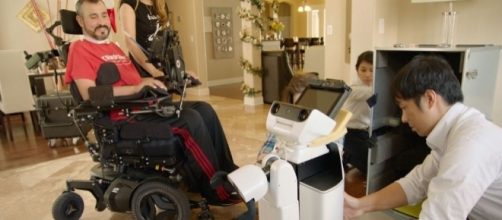Despite not being much in mainstream tech news, there are lots of robots being designed by companies all over the world. From startups to big brand names, they seek to create an end product that could become a mass-production hit with consumers. Some robotic developments are modest, like the Gita cargo Robot from Piaggio, which can carry groceries and follow their owners like a dog. Others are more complex like the Robocop-like automaton at the Fourth Gulf Information Security Expo and Conference in the UAE, which can supposedly read human emotions and body language.
Japanese automaker Toyota is no slouch either, with a new robot of their design being put through its paces by helping a paralyzed Army veteran.
Home assistant
The Toyota “Human Support Robot” is a prototype robotic helper that can autonomously perform tasks at the behest of humans. For this trial run the Japanese automobile giant is partnering their in-home robot with somebody who can really get a lot of mileage out of its functions. Said partner is Romy Camargo, a US Army Ranger veteran who was paralyzed by a neck gunshot wound in Afghanistan nearly ten years ago. Helping Camargo with certain tasks will gauge the Human Support Robot’s worth as a robot aide for elderly and disabled persons.
Standing at 3 feet tall and weighing 81 pounds, the Toyota Human Support Robot is fitted with sensors that enable it to navigate around a location whose layout has been downloaded into its memory.
Facial recognition software helps it recognize its current owner and remember other people, while its single robotic arm enables it to do reach out and grasp objects. It can, therefore, engage in motor tasks ranging from fetching water bottles for Camargo or drawing away curtains from a window to let light in. Its facial recognition enables the robot to recognize Camargo outside the house and open the door for him by an electronic lock.
A look at the future
By means of a smartphone app, Romy Camargo is able to maneuver the Toyota Human Support Robot to help him with various tasks around his home. With the robot’s help, he finds himself being able to care for himself even when his wife – with whom he runs a nonprofit helping other people like him with spinal cord injuries – is busy elsewhere.
The paralyzed veteran is very hopeful about the potential of Toyota’s prototype home robot, despite the reality that it will take more years of testing and fine-tuning before it will truly be ready. "Just knowing that this is going to help so many people -- for me, it was awesome," Camargo spoke of the Home Support Robot.


